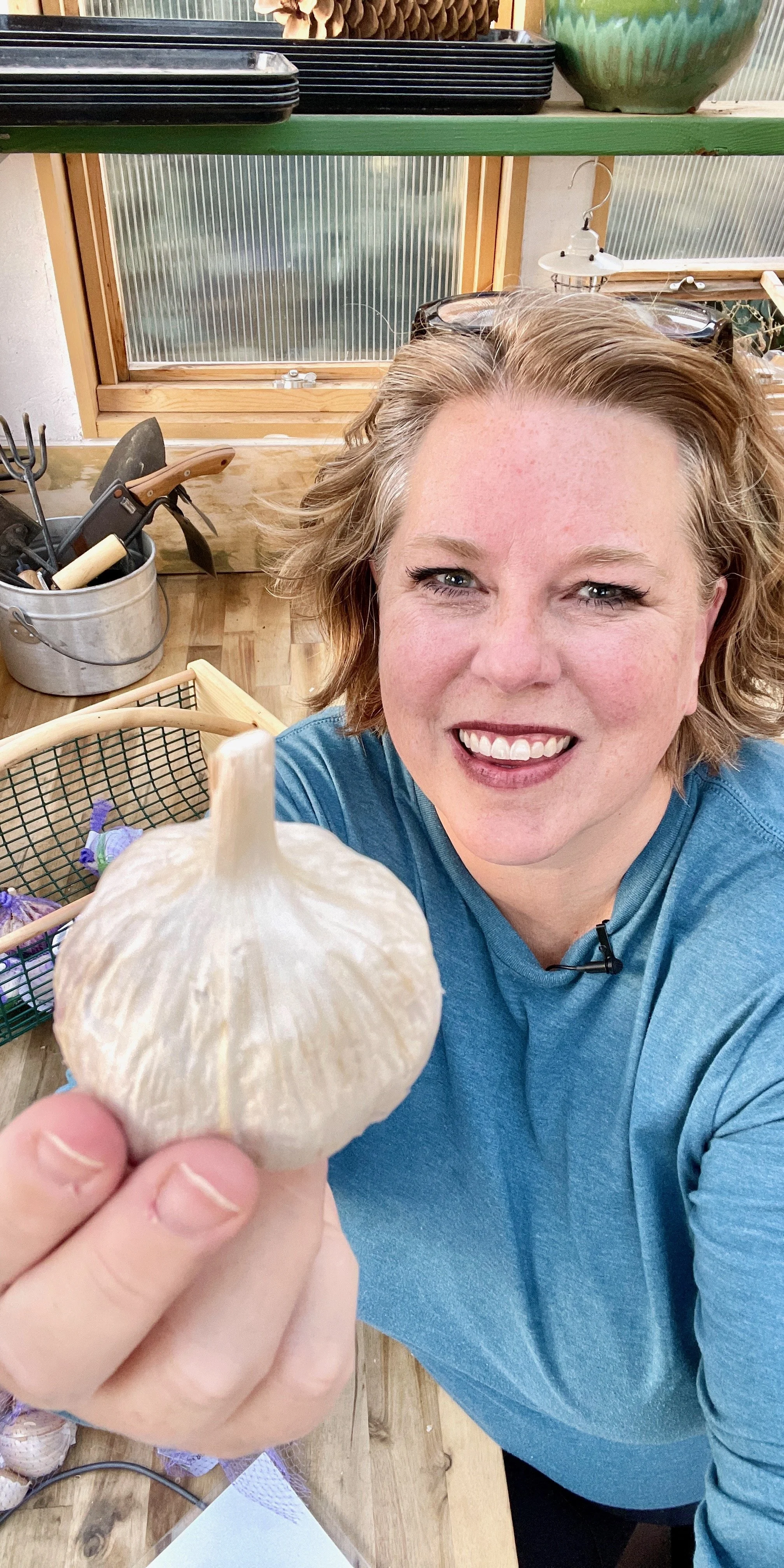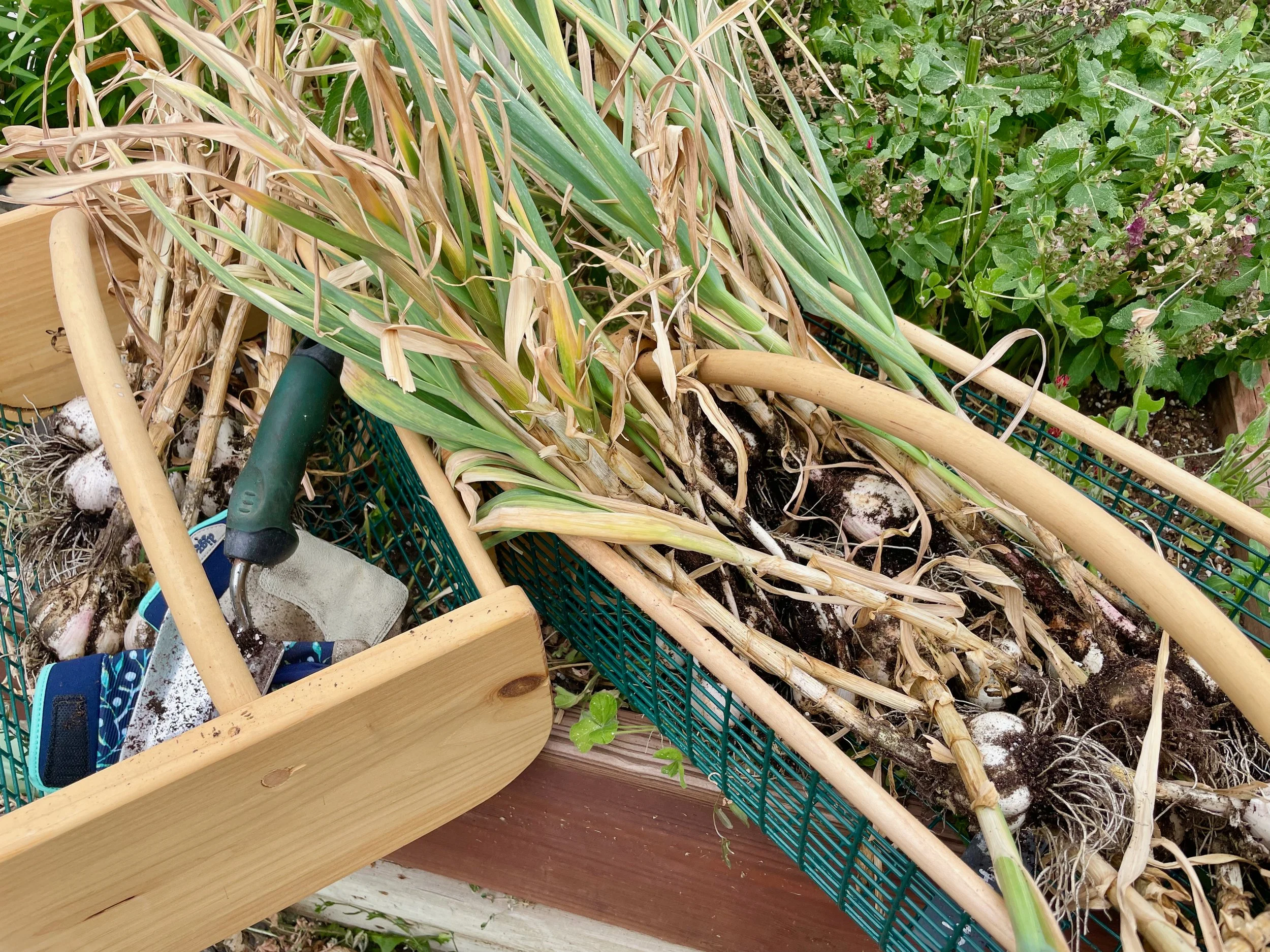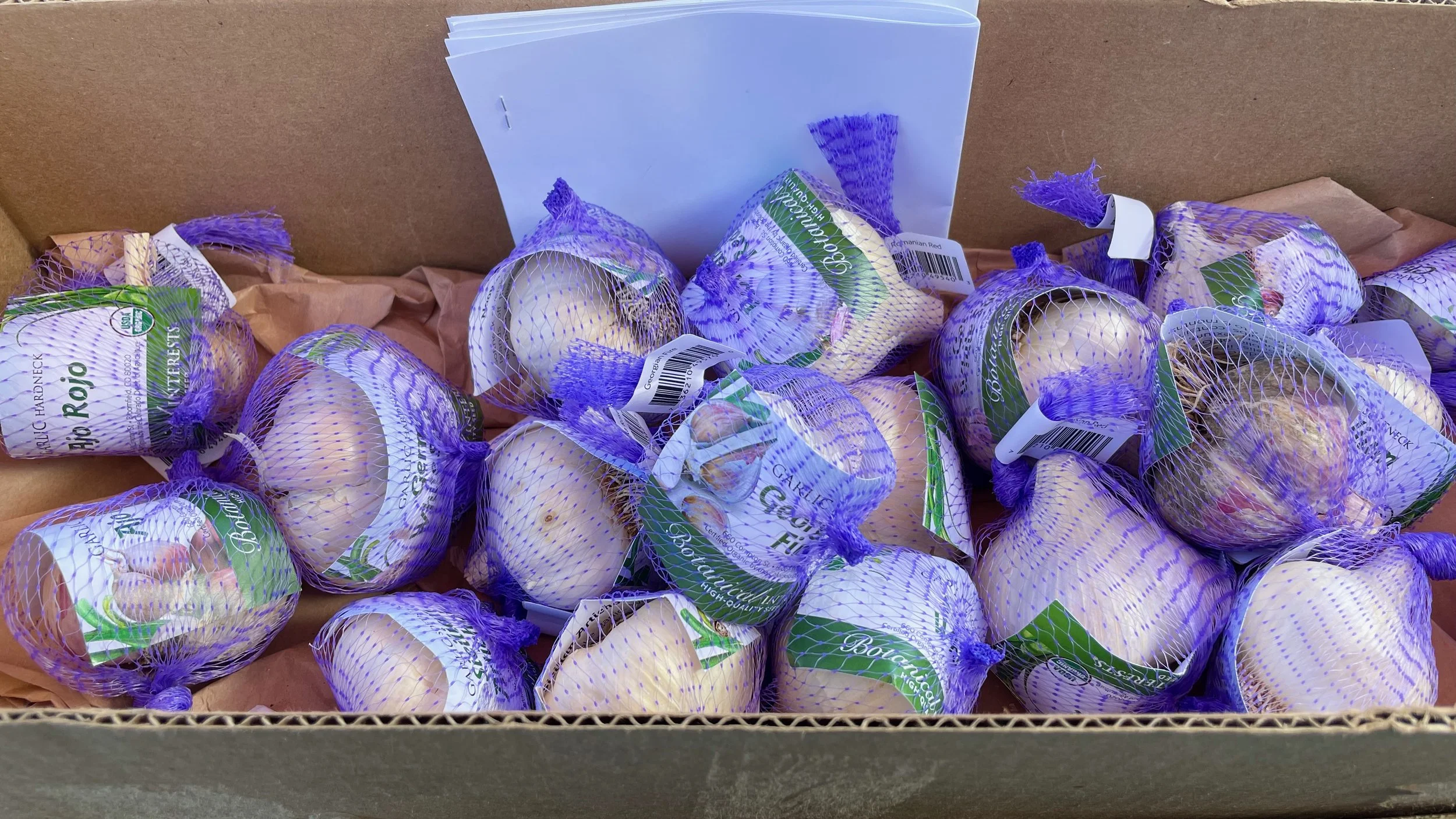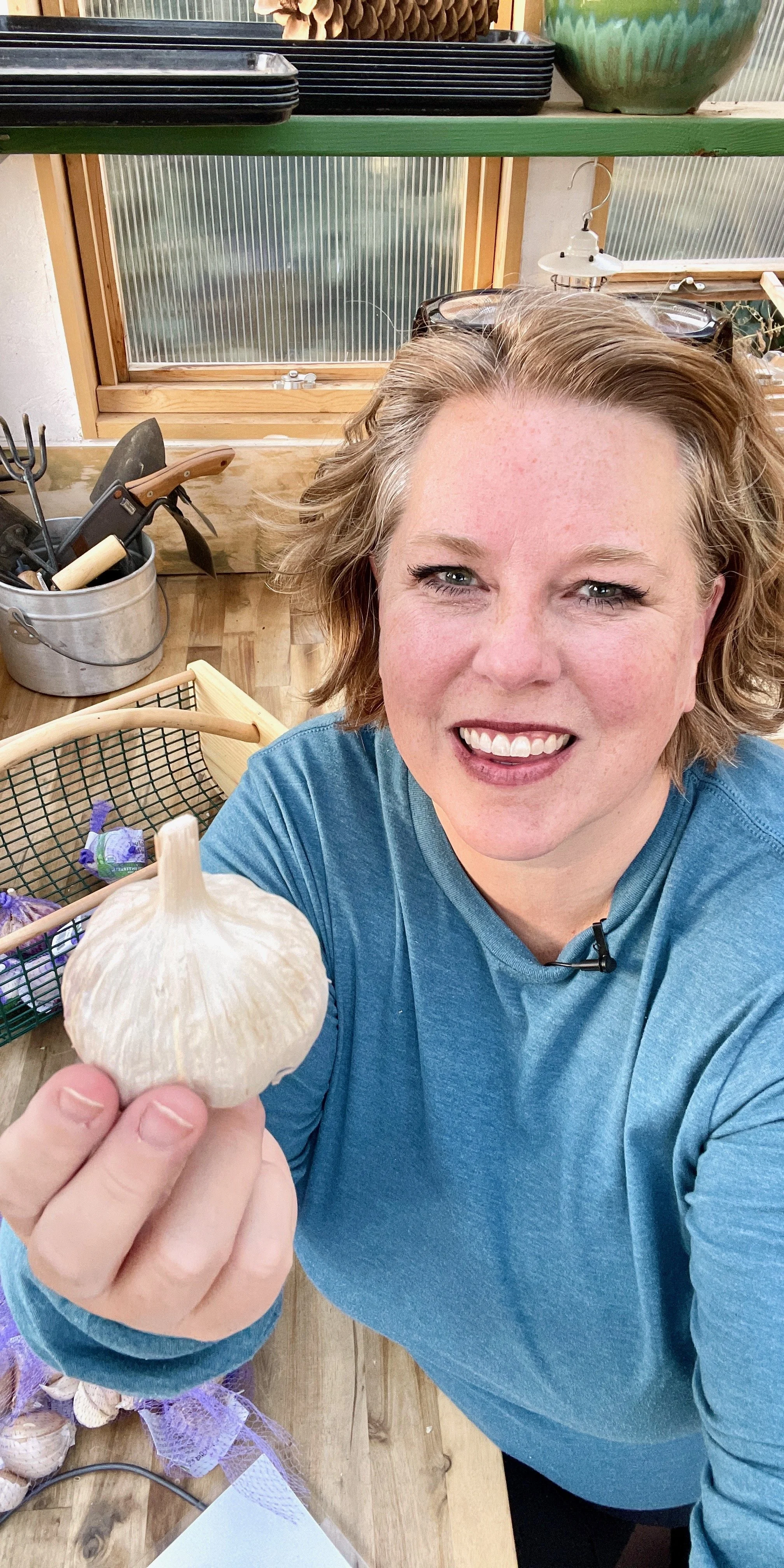How to Plant Garlic in the Fall:
a Step-by-Step Guide
It’s a beautiful fall day—cool air, crisp leaves, and the perfect time to get your hands dirty in the garden. If you’ve ever wondered why fall is the best time to plant garlic, or how to do it properly, you’re in the right place. Let’s dive into everything you need to know about planting garlic in autumn, whether you’re a seasoned gardener or just getting started.
Why Plant Garlic in the Fall?
One of the most common questions I get is, “Why plant garlic in the fall instead of spring?” Great question! Garlic is a bulb, and like most bulbs, it benefits from being in the ground before the soil freezes.
In my Zone 5|6 garden, the ground freezes hard in winter. That’s why it’s crucial to get garlic in the ground in the fall while the soil is still warm. This allows the cloves to start putting down roots. You might even see some green shoots emerge before winter sets in, and that’s completely fine!
The garlic then goes dormant through the winter, benefiting from natural moisture from snow and rain. When spring arrives, it wakes up and takes off growing strong.
If you live in a warmer climate where the ground doesn’t freeze, you have a longer planting window—usually until January. But for those of us in colder zones, fall is the best time to get those cloves into the soil.
Garlic Planting 101
I made this video for Botanical Interests a few years ago. Enjoy!
Choosing the Right Garlic: Softneck vs. Hardneck
There are hundreds of garlic varieties out there, but they generally fall into two main types: softneck and hardneck.
Here’s the difference:
Softneck Garlic
Found in most grocery stores
Grows well in warmer climates
Doesn’t require cold stratification
Can be braided for storage
Typically matures faster
Hardneck Garlic
Best for colder climates
Requires a period of cold dormancy
Produces a flower stalk (called a "scape")
Typically has stronger flavor
Stores for a shorter time than softneck
Garlic I like to Grow
I live in Colorado, where I’m lucky enough to be able to grow both. This year, I’ll be planting a mix of hardneck and softneck varieties to enjoy a range of flavors and growing habits.
Hardneck Varieties
Chesnok Red
Mount Hood
Russian Red
Montana Zemo
Elephant Hardneck
Softneck Varieties
Inchelium Red
Sicilian Artichoke
Nootka Rose
Italian Loiacono
I have an affiliate link for Botanical Interests if you want to support Wild Revival. Here’s the link, and if you use the code WILDREVIVAL you’ll get 5% off your order!
Choosing the Right Spot
Garlic needs full sun, so make sure you’re planting it in a spot that gets at least 6 hours of direct sunlight per day. I plant mine in raised beds with great sun exposure and some reflected heat from nearby driveways, which helps protect the garlic during the colder months.
If you have a sprinkler or irrigation system, be careful that your garlic won't be overwatered. This is particularly true if you don't need to turn off your sprinklers in the winter. Overwatering can lead to rotten garlic heads!
I also like to add compost in the fall when I am growing garlic. Compost improves moisture retention, adds a little nutrition, and increases the microbial life in your soil, and garlic seems to particularly love it!
How to Prepare Garlic for Planting
Before planting, you’ll need to prep your garlic heads:
Gently remove the outer papery layer of the garlic bulb.
Separate the cloves, being careful not to damage them.
Sort your cloves—only plant the large, healthy, heavy ones. Avoid any that are very small or dried out, as they won’t produce good heads of garlic.
Remember: each clove becomes an entirely new garlic bulb!
Planting Garlic: Spacing and Depth
When it’s time to plant, spacing is important:
Large cloves (like elephant garlic): plant 8 to 10 inches apart
Regular cloves: plant 6 to 8 inches apart
You can even plant a little closer if you're tight on space. In the spring, you can interplant between garlic with shallow-rooted crops like spinach to maximize your garden space.
More Tips for Great Garlic
Winter Watering
If you live in a drier climate like I do in Colorado, don’t forget to water your garlic during the winter. I water mine every 2 to 3 weeks unless we’ve had snow or rain. Garlic doesn’t like to dry out completely, even while it’s dormant.
If you see sprouts in the fall, don’t worry—this is completely normal. The plant will pause growth once the ground freezes and pick up again in spring.
My Secret for Keeping Squirrels and Critters Away
Worried about squirrels or other creatures digging up your garlic? Here's my tried-and-true method:
After planting, cover your garlic bed with a 4-inch layer of fallen leaves.
Add a layer of burlap on top of the leaves.
Burlap is biodegradable, reusable, and provides great protection. I leave the burlap in place until around mid-March, depending on when the garlic starts to come up. Then I remove just the burlap and leave the leaves, which continue to break down and enrich the soil.
By spring, your garlic will emerge beautifully—and the squirrels will have lost interest.
at the close…
Planting garlic in the fall is one of the most rewarding garden tasks. It's easy, low-maintenance, and sets you up for a delicious harvest next summer. Whether you're planting hardneck, softneck, or a little of both, following these tips will help you grow strong, healthy garlic plants.
Got questions about growing garlic? Drop them in the comments—I’d love to help!
And don’t forget to like and subscribe if you found this helpful!
Happy planting!
Subscribe now so you never miss a thing!








